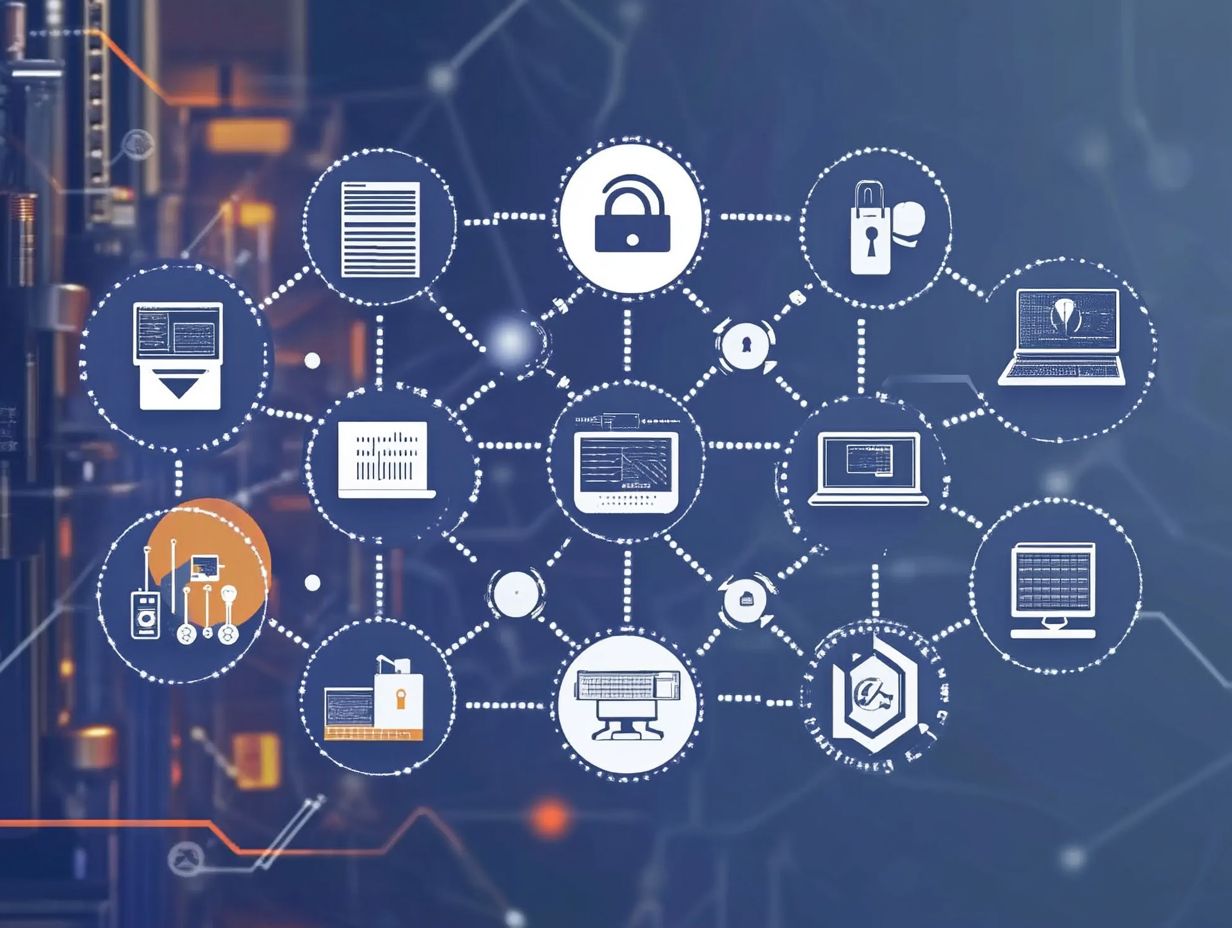the evolution of cybersecurity compliance
In today s digital landscape, ensuring cybersecurity compliance is crucial for organizations like yours that aim to protect sensitive data and uphold trust.
Let s explore the evolution of cybersecurity compliance, tracing significant developments and shedding light on the current challenges your business may encounter.
This article discusses the impact compliance has on financial stability and reputation while contemplating emerging technologies and trends that will influence its future.
With best practices and practical guidelines at your fingertips, this piece serves as a valuable resource for navigating the intricate world of cybersecurity compliance.
Contents
- Key Takeaways:
- Definition and Importance
- Evolution of Cybersecurity Compliance
- Current State of Cybersecurity Compliance
- Impact of Cybersecurity Compliance on Businesses
- Future of Cybersecurity Compliance
- Best Practices for Cybersecurity Compliance
- Frequently Asked Questions
- What is the meaning of cybersecurity compliance?
- How has the evolution of technology impacted cybersecurity compliance?
- How has the approach to cybersecurity compliance changed over the years?
- What role do regulations and laws play in cybersecurity compliance?
- How has the COVID-19 pandemic affected cybersecurity compliance?
- What can organizations do to stay up to date with the evolving landscape of cybersecurity compliance?
Key Takeaways:
- Cybersecurity compliance is crucial for protecting businesses from cyber threats and ensuring the safety of sensitive data.
- The evolution of cybersecurity compliance has seen significant developments and continues to evolve with emerging technologies and trends.
- Non-compliance with cybersecurity regulations can have severe financial and reputational consequences for businesses, highlighting the importance of adhering to best practices for implementation.

Definition and Importance
In today’s increasingly interconnected world, understanding cybersecurity compliance goes far beyond simply ticking regulatory boxes; it forms a vital framework that safeguards the integrity and security of your digital information, highlighting the link between compliance and cyber resilience amid constantly evolving threats.
You need to align your cybersecurity policies with industry standards and best practices to effectively mitigate risks and ensure network compliance.
This alignment becomes even more crucial as the cybersecurity landscape shifts, underscoring the necessity for robust compliance measures that can adapt to emerging challenges and technological advancements.
Evolution of Cybersecurity Compliance
The evolution of cybersecurity compliance has been defined by pivotal milestones, such as the Federal Information Security Management Act (FISMA). This law established foundational standards for government organizations and crafted a framework for the effective management of cybersecurity risks, mirroring continual advancements in technology and the rise of new compliance mandates.
As you navigate the growing demands for adherence to international compliance standards, integrating NIST guidelines becomes crucial. This integration empowers you to establish a robust compliance strategy that effectively addresses both present and future cybersecurity challenges.
Timeline of Key Developments
The timeline of key developments in cybersecurity compliance reveals a significant shift toward comprehensive risk management strategies, particularly with the introduction of the NIST Cybersecurity Framework. For those looking to understand more, here’s what you should know about cybersecurity compliance. This framework provides a structured approach to tackle cybersecurity threats while enhancing your compliance measures.
It has been instrumental in guiding organizations through the evolving compliance landscape, especially following notable breaches that highlighted the urgent need for robust cybersecurity protocols.
As industries face a surge in sophisticated cyber-attacks like the Equifax breach in 2017, which compromised sensitive data for millions regulators have responded by tightening compliance requirements. The implementation of regulations such as GDPR in Europe and HIPAA in the healthcare sector underscores the critical necessity to protect personal information.
By adopting the NIST Framework, you align with these regulations and build a resilient infrastructure that minimizes risks. Taking proactive steps based on these guidelines allows you to significantly enhance your security posture, safeguarding your organization from the financial and reputational repercussions of non-compliance.
Current State of Cybersecurity Compliance

The current landscape of cybersecurity compliance presents you with a rapidly changing environment filled with new challenges, driven by an uptick in threats and increasingly sophisticated attacks, highlighting the impact of non-compliance in cybersecurity.
You ll encounter compliance challenges that demand your attention, such as the adoption of security models like Zero Trust Architecture, which requires strict identity verification for access, and Continuous Monitoring.
Embracing this multi-faceted approach to compliance is essential for your organization as you work to safeguard sensitive data while navigating the complexities of regulatory adherence in a risky cybersecurity environment.
Take the first step today to fortify your cybersecurity compliance and protect your business!
Challenges and Concerns
One of the foremost challenges in cybersecurity compliance is the threat of not following rules, which can lead to severe financial and reputational damage. This shows that strong risk management strategies are vital. Adequate cybersecurity funding is crucial.
As you navigate the complexities of regulations, addressing these concerns is essential for maintaining compliance and protecting your valuable digital information.
This urgency intensifies in a landscape that is always changing, where regulatory shifts can arise unexpectedly and demand immediate action. You may find yourself struggling with limited resources, a lack of expertise, and increasing pressure to implement thorough security measures.
These challenges can block your path to security and affect your ability to allocate budgets toward cybersecurity efforts. Consequently, you may face tough choices between investing in compliance initiatives and meeting other operational needs. This can lead to a fragmented approach, increasing your vulnerability to breaches and potential fines.
Impact of Cybersecurity Compliance on Businesses
The impact of cybersecurity compliance on your business is profound, affecting both finances and reputation.
Not adhering to industry rules can result in hefty penalties, a loss of consumer trust, and a weakened market position.
By prioritizing compliance, you not only protect your assets but also enhance your credibility and operational resilience against rising cybersecurity threats.
Financial and Reputational Consequences
The financial and reputational fallout from compliance issues can be devastating for organizations. High-profile incidents like the Heartland Payment Systems and Equifax breaches illustrate this point. These events caused significant monetary losses and severely damaged the reputations of these firms in a competitive cybersecurity landscape.
Such breaches serve as stark reminders of the need for strong compliance frameworks designed to guard against emerging threats.
The aftermath of these incidents emphasizes the importance of having timely and effective incident response strategies. For instance, Heartland faced costs exceeding $140 million due to legal fees, settlements, and regulatory fines. Equifax’s data breach affected around 147 million individuals, leading to a dramatic decline in shareholder trust and a staggering $700 million settlement.
Organizations increasingly recognize that comprehensive compliance and cybersecurity strategies are essential not only for legal conformity but also for maintaining stakeholder confidence and ensuring long-term market survival.
Future of Cybersecurity Compliance

The future of cybersecurity compliance will be shaped by emerging technologies and trends, including artificial intelligence and privacy considerations.
You must align your security measures now with the evolving cloud security standards and regulatory requirements. By adopting this proactive strategy, you tackle today’s compliance challenges and position your organization to effectively manage potential risks from future technological advancements.
Emerging Technologies and Trends
Emerging technologies like quantum computing and advances in automation are set to transform the cybersecurity compliance landscape. These developments compel you to rethink your compliance strategies to navigate new challenges and seize opportunities.
As you work with service partners to harness these technologies, it’s crucial that your compliance frameworks remain flexible and robust.
The integration of quantum computing could significantly enhance your data encryption methods, giving you a strong edge in protecting sensitive information. Automation can streamline your compliance processes, helping you monitor and report your cybersecurity measures efficiently.
However, this rapid development brings its own risks, particularly in the form of new vulnerabilities that could be exploited.
Your effective compliance strategies must adapt not only to the capabilities and threats these technologies introduce but also adopt a proactive approach, allowing you to stay ahead in an increasingly complex regulatory environment.
Best Practices for Cybersecurity Compliance
Establishing best practices for cybersecurity compliance is essential for organizations like yours that aim to navigate the ever-changing landscape of compliance.
Embracing methods such as DevSecOps, which combines development, security, and operations, and Mobile Device Management can significantly enhance your security posture. By adopting these practices, you ensure adherence to regulations while fortifying your defenses against emerging cybersecurity threats.
Guidelines for Implementation
You need a clear plan to implement cybersecurity compliance guidelines effectively. This structured approach aligns with regulatory requirements and addresses the evolving landscape of cybersecurity threats.
Collaborating with automation and service partners can bolster your security measures. Establish clear protocols defining your compliance strategies to ensure they remain effective against shifting challenges.
Start by conducting thorough risk assessments to pinpoint vulnerabilities and potential regulatory gaps. Stay ahead of changing regulations to protect your organization now; this knowledge will inform the continuous refinement of your cybersecurity strategies.
Integrating automated tools for real-time monitoring can significantly streamline your compliance processes, minimizing human error and enhancing efficiency. Tapping into specialized service partners offers insights and support to develop tailored compliance solutions, positioning you proactively in the realm of cybersecurity.
Ultimately, by embedding compliance into your organizational culture and operations, you safeguard your data while maintaining the trust of your stakeholders.
Frequently Asked Questions

What is the meaning of cybersecurity compliance?
Cybersecurity compliance refers to following a set of rules, regulations, and standards designed to protect an organization’s digital assets from cyber threats and attacks. These compliance measures ensure that an organization follows best practices to safeguard its data and information.
How has the evolution of technology impacted cybersecurity compliance?
The evolution of technology has significantly impacted cybersecurity compliance by leading to a proliferation of new cyber threats and attacks. As technology advances, understanding compliance in cybersecurity becomes essential, and new, more sophisticated cybersecurity measures are necessary to protect against these threats.
How has the approach to cybersecurity compliance changed over the years?
In the past, cybersecurity compliance focused mainly on implementing technical solutions such as firewalls and antivirus software. However, the increase in cyber attacks and data breaches has shifted the approach towards a more holistic strategy that includes policies, procedures, and employee training.
What role do regulations and laws play in cybersecurity compliance?
Regulations and laws are crucial in cybersecurity compliance as they set the standards and guidelines for organizations to follow. Regulations like GDPR and HIPAA outline the consequences for failing to comply with cybersecurity measures.
How has the COVID-19 pandemic affected cybersecurity compliance?
The COVID-19 pandemic has significantly impacted cybersecurity compliance. The sudden shift to remote work has increased the risk of cyber attacks, and organizations have had to adapt their cybersecurity measures to ensure the security of their remote workforce and data.
What can organizations do to stay up to date with the evolving landscape of cybersecurity compliance?
Regularly review and update your policies to keep your organization compliant. Invest in employee training and stay informed about new cyber threats and regulations.
To summarize, evaluate your cybersecurity compliance practices today to ensure a secure and trusted environment for your organization.






